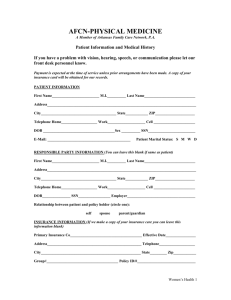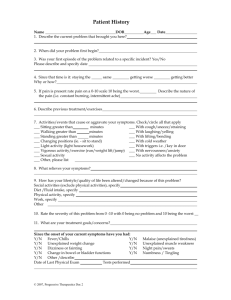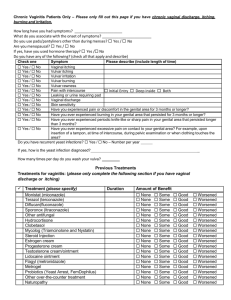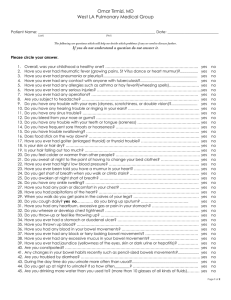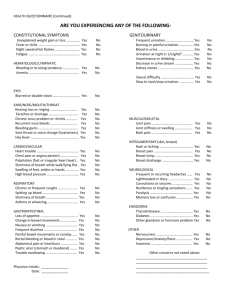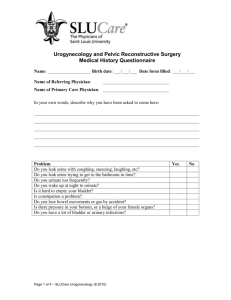Pelvic Pain Patients
advertisement
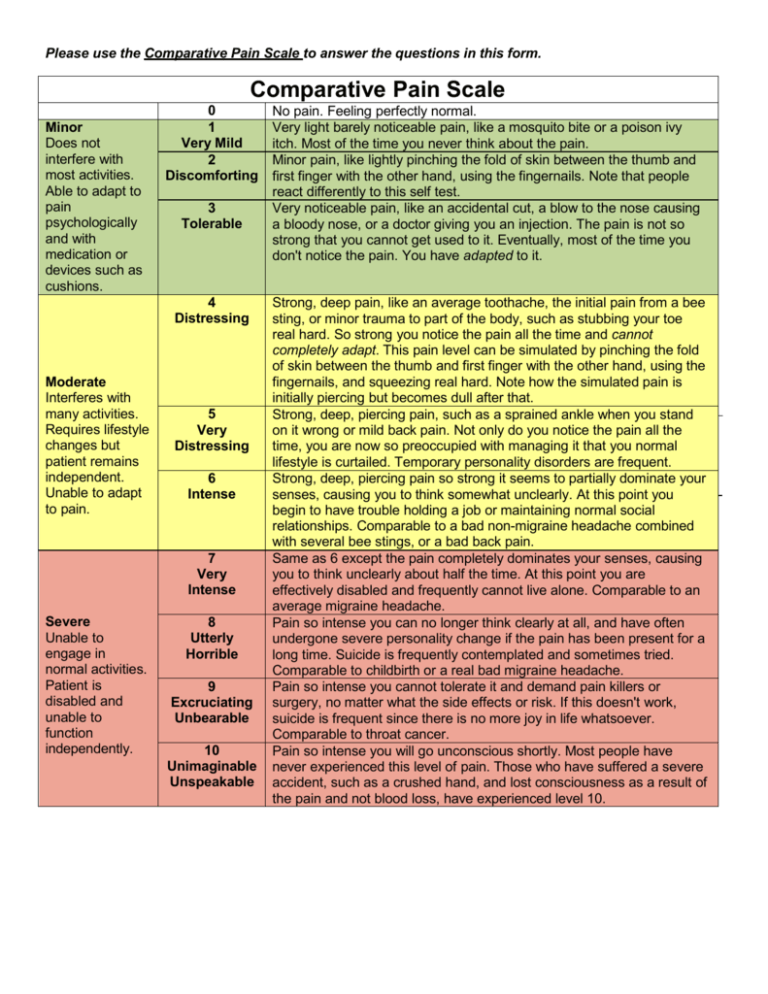
Please use the Comparative Pain Scale to answer the questions in this form. Comparative Pain Scale Minor Does not interfere with most activities. Able to adapt to pain psychologically and with medication or devices such as cushions. 0 1 Very Mild 2 Discomforting 3 Tolerable 4 Distressing Moderate Interferes with many activities. Requires lifestyle changes but patient remains independent. Unable to adapt to pain. 5 Very Distressing 6 Intense 7 Very Intense Severe Unable to engage in normal activities. Patient is disabled and unable to function independently. 8 Utterly Horrible 9 Excruciating Unbearable 10 Unimaginable Unspeakable No pain. Feeling perfectly normal. Very light barely noticeable pain, like a mosquito bite or a poison ivy itch. Most of the time you never think about the pain. Minor pain, like lightly pinching the fold of skin between the thumb and first finger with the other hand, using the fingernails. Note that people react differently to this self test. Very noticeable pain, like an accidental cut, a blow to the nose causing a bloody nose, or a doctor giving you an injection. The pain is not so strong that you cannot get used to it. Eventually, most of the time you don't notice the pain. You have adapted to it. Strong, deep pain, like an average toothache, the initial pain from a bee sting, or minor trauma to part of the body, such as stubbing your toe real hard. So strong you notice the pain all the time and cannot completely adapt. This pain level can be simulated by pinching the fold of skin between the thumb and first finger with the other hand, using the fingernails, and squeezing real hard. Note how the simulated pain is initially piercing but becomes dull after that. Strong, deep, piercing pain, such as a sprained ankle when you stand on it wrong or mild back pain. Not only do you notice the pain all the time, you are now so preoccupied with managing it that you normal lifestyle is curtailed. Temporary personality disorders are frequent. Strong, deep, piercing pain so strong it seems to partially dominate your senses, causing you to think somewhat unclearly. At this point you begin to have trouble holding a job or maintaining normal social relationships. Comparable to a bad non-migraine headache combined with several bee stings, or a bad back pain. Same as 6 except the pain completely dominates your senses, causing you to think unclearly about half the time. At this point you are effectively disabled and frequently cannot live alone. Comparable to an average migraine headache. Pain so intense you can no longer think clearly at all, and have often undergone severe personality change if the pain has been present for a long time. Suicide is frequently contemplated and sometimes tried. Comparable to childbirth or a real bad migraine headache. Pain so intense you cannot tolerate it and demand pain killers or surgery, no matter what the side effects or risk. If this doesn't work, suicide is frequent since there is no more joy in life whatsoever. Comparable to throat cancer. Pain so intense you will go unconscious shortly. Most people have never experienced this level of pain. Those who have suffered a severe accident, such as a crushed hand, and lost consciousness as a result of the pain and not blood loss, have experienced level 10. Understanding your pain Please describe your pain problem: What do you think is causing your pain? I don’t know How long have you had this pain? < 6 months 6 months – 1 year 1-2 years >2 years Where is your most significant pain located? Was the onset of your pain sudden or gradual over time? sudden gradual When did it start? Is there an event that you associate with the onset of pain? Yes No If so, what? Does your pain radiate? Yes No If so, where? Is your pain: getting worse getting better staying the same What helps your pain? Meditation Relaxation Lying down Music Motrin/Alleve/etc Massage Ice Heat Hot bath Certain movements Pain medication Laxatives/enema Injection TENS unit Physical therapy Bowel movement Emptying bladder Activity Nothing Other: Nothing Orgasm Sex Full meal What makes your pain worse? Sitting Bowel movement Full bladder Urination Standing Changing Positions Walking Exercise Time of day Weather Anxiety Lifting Stress Contact with Coughing/sneezing clothing How long can you sit before you have to stand due to pain?____________ Vigorous activity Light activity Other: What is the worst type of pain that you have ever experienced? Kidney stone Labor & delivery Bowel Migraine Current pelvic obstruction headache pain Backache Broken bone Surgery Other: How does your pain affect your daily activities? No Effect Using the comparative pain scale (page 1), answer the following questions. Please use WHOLE NUMBERS ONLY to rate the pain How would you rate your current pain? How would you rate your maximal pain level? What would be an acceptable level of pain? How would you rate your lowest pain level while awake? How would you rate your average pain? Please check the below any problems that are a significant component of your pain and rate the pain level in the ( ) using the Comparative Pain Scale. WHOLE NUMBERS ONLY Pain in groin when Pain with Pain with full bladder Migraine headache lifting, coughing or urination( ) ( ) ( ) sneezing ( ) Backache (___) Severe cramping Exacerbation of pain with Pain for days prior to pain with menstrual menstrual cycle ( ) menstrual cycle ( ) cycle (_ ) Deep pain with sex Pain on initial entry Burning vaginal pain with Pelvic pain lasting hours ( ) with sex ( ) sex ( ) or days after intercourse Every time / Most Every time / Most Every time / Most of ( ) Every time / Most of of the time of the time the time the time Mental Health History Note – It is our basic philosophy that your pain is real. Chronic pain has a physiologic basis, however, it is altered by emotional states. A history of depression or anxiety, while not a cause of your pain, may have a significant effect on your pain. Understanding some of these issues about you can better enable us to optimally manage your pain and allow you to reach your potential. Do you have a history of any of the following? (please check all that apply) Depression Bipolar Affective Dysthymic Suicide attempt Disorder disorder Anxiety Disorder Post Traumatic Schizophrenia Panic Disorder Stress Disorder Other: Sleep Disorder Agoraphobia Have you been hospitalized for depression? Yes / No Dates: Have you been treated by a psychiatrist? Yes / No Dates: Have you been treated by a psychologist? Yes/ No Dates: Are you still under treatment? Yes/ No Please list any medications and duration of use: Over the past two weeks, how often have you been bothered by the following problems: Not at all Several days More than half of the days (0) (1) (2) Feeling nervous, anxious, on edge Not being able to stop or control worrying Nearly every day (3) Select only 1 box per row. For the following questions, please select the ONE BEST number use 0-10, no fractions. Please use the Comparative Pain Scale 0 1 2 3 4 5 6 7 8 9 to answer the questions (page 1) How would you rate your pelvic pain on a 0-10 scale at the present time (right now) where 0 is “no pain” and 10 is “pain as bad as it could be?” In the past 6 months, how intense was your worst pain rated on a 0-10 scale, where 0 is “no pain” and 10 is “pain as bad as it could be?” In the past 6 months, on the average, how intense was your pain rated on a 0-10 scale, where 0 is “no pain” and 10 is “pain as bad as it could be”? (That is, your usual pain at times you were experiencing pain.) In the past 6 months, how intense was your least amount of pain (at any time awake) rated on a 0-10 scale, where 0 is “no pain” and 10 is “pain as bad as it could be?” About how many days in the past 6 months have you been kept from your usual activities (work, school or housework) because of pelvic/vulvar pain? _ In the past 6 months, how much has your pelvic/vulvar pain interfered with your daily activities rated on a 0-10 scale where 0 is “no interference” and 10 is “unable to carry out any activities”? In the past 6 months, how much has your pelvic/vulvar pain changed your ability to take part in recreational, social and family activities, where 0 is “no change” and 10 is “extreme change”? In the past 6 months, how much has your pelvic/vulvar pain changed your ability to work (including housework) where 0 is “no change” and 10 is “extreme change”? In the past 6 months, how much has your pelvic/vulvar pain changed your ability to take part in sexual activities where 0 is “no change” and 10 is “unable to participate in sexual activities”? 10 The words below describe average pain. Circle the number in the column which represents the degree to which you feel that type of pain. Please limit yourself to a description of the pain in your pelvic area only. None Mild Moderat Severe e Office Use Only Throbbing 0 1 2 3 Shooting 0 1 2 3 SF-MPQ Scoring Stabbing 0 1 2 3 S= Sharp 0 1 2 3 Cramping 0 1 2 3 A= Gnawing 0 1 2 3 Hot-Burning 0 1 2 3 T= Aching 0 1 2 3 Heavy 0 1 2 3 Tender 0 1 2 3 Splitting 0 1 2 3 Tiring0 1 2 3 E xhausting Sickening Fearful Punishing-Cruel 0 0 0 1 1 1 2 2 2 3 3 3 Treatments for pelvic pain: (please only complete the following section if you have pelvic pain) Treatment (please c) Duration Amount of Benefit NSAID – Motrin, Alleve, Anaprox, Daypro, None Some Good Worsened or similar Mild opioid – Lortab, Vicodin, Vicoprofen None Some Good Worsened or similar Narcotic – Percocet, Oxycontin, Morphine, None Some Good Worsened Dilaudid or similar Seizure medication – neurontin, Topamax None Some Good Worsened Lupton or Synnarel None Some Good Worsened Elavil, Pamelor, amitriptyline, nortriptyline, None Some Good Worsened Desipramine Birth control pills None Some Good Worsened Provera, Depo Provera None Some Good Worsened Danazol None Some Good Worsened Tens Unit None Some Good Worsened Nerve blocks None Some Good Worsened Testosterone cream/ointment None Some Good Worsened Trigger point injections None Some Good Worsened Accupuncture None Some Good Worsened Herbal medicines / naturopathy None Some Good Worsened Physical therapy None Some Good Worsened Psychotherapy None Some Good Worsened Other counseling None Some Good Worsened None Some Good Worsened None Some Good Worsened Social History Who lives at home with you? What caffeine do you consume: coffee soda tea energy drinks caffeine pills none How many 8 oz cups per day do you consume? 0 1-3 4-6 >7 Have you ever smoked tobacco? No / Yes - How many years? How many cigarettes do/did you smoke per day? Have you ever tried to quit? Yes / No How many times in the past year have you had 4 or more drinks in a day? How many times in the past year have you used an illegal drug or used a prescription medication for nonmedical reasons? Any history of illegal drug use? No Yes, currently In the past but not now Have you ever received treatment for substance abuse? Yes / No How many hours per week do you exercise? None 1-3 4-6 6-10 >10 What type of exercise? [Check all that apply] Weight lifting Cardio Walking Running Fitness Ab exercises Team sports Biking/Spinning Yoga/Pilates Other: classes Do you currently or previously engage in the following activities? [Check all that apply] Bicycling/spinning Gardening Dancing Golf Gymnastics Horseback riding Heavy lifting Weight Training Other: What do you do to relax? Have you been involved in any serious motor vehicle accident? Yes / No Hospitalized? Yes / No Have you suffered from any of the following [Check all that apply] Back injury Lifting injury Straddle (bicycle bar, fence, balance beam, etc) Ankle/Foot injury or problems Coccyx/Tailbone injury Fall on buttocks Broken bones Sports injuries Please provide dates and details of injury: What are your current stressors? [Check all that apply] None Recent/planning move Marital strain Separation/divorce Child rearing Relationship difficulties Job status change/difficulties Financial difficulties Disability claim Death in the family Family illness/caregiving Law suit/legal troubles Other: Bladder Function Do you experience any of the following? (check all that apply and describe) Check one Symptom Please describe Yes / No Loss of urine with coughing, sneezing, or laughing Yes / No Frequent urination Number of Daytime voids: 8 or less 9 – 15 >16 Number of Nighttime voids: 0 1 2-3 >=4 Yes / No Need to urinate with little warning Yes / No Frequent bladder infections Yes / No Feeling the need to void even after urination Voiding Symptom Questionnaire Not at all Less than 1 time in 5 Less than half the time Almost half the time More than half the time Almost always 0 1 2 3 4 5 0 1 2 3 4 5 0 1 2 3 4 5 0 1 2 3 4 5 Over the past month, how often have you had a weak urinary stream? 0 1 2 3 4 5 Over the past month, how often have you had to push to strain to begin urination 0 1 2 3 4 5 Over the past month, how often have you had a sensation of not emptying your bladder completely after you finished urinating Over the past month, how often have you had to urinate again less than 2 hours after you finished urinating? Over the past month, how often have you found you stopped and started again several times when you urinated? Over the past month, how often have you found it difficult to postpone urination? Over the past month, how many times did you 0 1 2 3 4 typically get up to urinate from the time you went to bed at until the time you got up in the morning? Select actual number of times you void during the night. IC Symptom Index Using the IC Symptom Index key to the left, answer the following: 1. Not at all During the past month: 2. Less than 1 time in 5 Q1. How often have you felt the strong need to urinate with little or no warning? 3. Less than half the time Q2. Have you had to urinate less than 2 hours after you finished urinating? 4. About half the time Q3. How often did you most typically get up at night to urinate? 5. More than half the time Q4. Have you experienced pain or burning in your bladder? 6. Almost always IC Problem Index 1. No problem 2. Very small problem 3. Medium problem 4. Big problem Using the IC Problem Index key to the left, answer the following: During the past month, how much has each of the following been a problem for you: Q1. Frequent urination during the day? Q2. Getting up at night to urinate? Q3. Need to urinate with little warning? Q4. Burning, pain, discomfort, or pressure in your bladder? 5 or more Office Use Only AUA Score: IC Symptom Index: IC Problem Index: Bowel Function Yes / No Have you had recurrent abdominal pain or discomfort at least 3 days per month in the last 3 months? Yes / No If YES – did it start more than 6 months ago? Yes / No Is there any improvement with a bowel movement? Yes / No Is the onset of pain associated with a change in frequency of stool? Yes / No Is the onset of pain associated with a change in form (consistency) of stool? Would you say that at least 25% of the occasions or days in the last 3 months you have had any of the following? (check all that apply) Fewer than 3 bowel movements per More than 3 bowel movements per Hard or lumpy stools week (0-2 bowel movements) day (4 or more bowel movements) Straining during a bowel movement Loose or watery stools Urgency – having to rush to the bathroom for a bowel movement Abdominal fullness, bloating, or Feeling of incomplete emptying Passing mucus (white material) swelling after a bowel movement during a bowel movement Pain Mapping Instructions: Please draw on the diagram: XXX for the most intense pain OOO for the most severe pain /// for mild pain Please fill out both the whole body and vulva diagram . Vulva Please check if you do not have vulvar pain. PLEASE place marks on the drawing itself, not by the words. Full Body (including abdomen and pelvis) Please check if you do not have pain demonstrated on this diagram. What would you like to tell us about your pain that we have not asked? Any other comments or anything that you feel is important for us to know?

